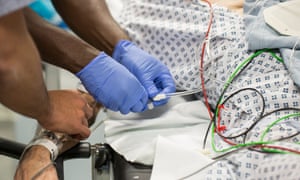 The strain of witnessing dying patients on trolleys in an overcrowded emergency department takes its toll on staff
The strain of witnessing dying patients on trolleys in an overcrowded emergency department takes its toll on staff
y heart sank as I heard the shrill sound of the red phone. I’d lost count of how many times it had rung since the start of my shift several hours earlier. I stood in the middle of the resuscitation room of the emergency department waiting for the nurse in charge to relay the details of the next patient whose arrival was imminent. I should have used the minutes that followed to prepare; ensure the team was briefed and all equipment ready. Instead I stood, head in hands, trying to decide which of the six seriously unwell patients already occupying the six beds in the room I could move out to make way for the new arrival.
I knew the rest of the department was at capacity. Capacity had been reached hours ago, and there were multiple patients in the department who had been with us for hours waiting for a bed on a ward to become available. The department was caring for double, perhaps triple the number of patients it was designed to do.Nursing staff were caring for patients who should have been in a bed on a ward elsewhere in the hospital. This was a distraction from dealing with the multitude of new arrivals. I knew they could only stretch themselves so far.
Everyone was working as hard as they could, but I wasn’t sure that the patient I was about to move out of the resuscitation room would get the care they needed. Who would check that essential medication was given? Who would ensure their pain was managed? Who would see if they were deteriorating? Who was looking after the ever growing queue in the corridor?
The red phone rang again. It was no longer one critical patient about to arrive, it was three. It was hours before I managed to leave the resuscitation room to check on the patients I’d had to move. I found a patient still waiting to receive essential intravenous antibiotics I thought I’d already prescribed. It must have slipped my mind when another patient had arrived with severe breathing difficulties. On a standard day the aim would be for these antibiotics to be given within an hour of arrival. Care had been compromised. I was lucky this time; no one died as a result of the substandard care I was forced to provide. Luck shouldn’t come in it.
It’s well known that emergency departments across the country have experienced unprecedented demand over the last months. The concepts of crowding (pdf) andexit block have been voiced and gained traction thanks to the ongoing work of the Royal College of Emergency Medicine. I’m confident that failure to meet the four hour target is, at least by the majority, no longer seen as solely an A&E issue, but more of a barometer of how a hospital is functioning. Maybe even a barometer of the entire NHS and social care.
Hardly a day went by last winter without a headline about the NHS winter crisis, yet this year the data is much harder to access. The government’s decision to change data reporting means that the public can no longer type their postcode into the BBC webpage to see how their local trust performed the week before.
Forget Jeremy Hunt’s questionable statistics on deaths at weekends. We know that patients cared for in crowded A&E departments will have worse outcomes. We see first-hand the strain on staff of working, day in day out in overcrowded, chronically understaffed conditions. The strain of knowing you can’t give the best care you so desperately want because you just don’t have the resources. The strain of witnessing, yet again, a dying patient on a trolley as there is simply no room at the inn.
We do our best, but how often is that not enough? Staff are exhausted. The result, unsurprisingly, is increased stress and sick leave among staff. They leave or reduce their hours which only results in increased pressure to those that stay. The risk of burnout escalates, manifesting as emotional exhaustion and compassion fatigue. Patient care suffers as a result. Staff describe feeling that they have nothing left to give.
Last year a consultant friend told me they were leaving the NHS because they couldn’t face another winter working in A&E in England. This winter the government don’t seem to want to talk about these facts but instead their manifesto promise of a seven-day service. Our A&E is open 24/7 and always has been.
If you would like to write a blogpost for Views from the NHS frontline, read our guidelines and get in touch by emailing healthcare@theguardian.com.
Join the Healthcare Professionals Network to read more pieces like this. And follow us on Twitter (@GdnHealthcare) to keep up with the latest healthcare news and views.
No comments:
Post a Comment